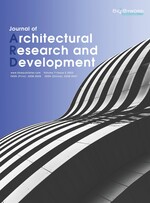Abstract
With the continuous exploration and research of low-carbon buildings in China, combined with foreign theories
and practices, there are a few basic theoretical and practical projects for low-carbon construction in major cities of China. However, throughout the entire academic research, there is still no comprehensive and clear guidance for the green and low-carbon research and transformation of rural self-built houses. Therefore, the existing development of low-carbon technology for rural self-built houses has been summarized, and some prospects for the future development of rural selfbuilt houses have been summarized. It is hoped that this will have positive help for future rural low-carbon transformation.
References
Institute of Rural Development, Chinese Academy of Social Sciences. 2017 China Rural Development Report, China Social Sciences Press, 2018, Beijing.
National Bureau of Statistics. China Rural Statistical Yearbook (2008–2017), China Statistics Press, 2018, Beijing.
Jones P, Li X. Proceedings of the 7th International Symposium on Architectural Interchanges in Asia (ISAIA), October 15–17, 2008: Low-Carbon Building Design: European Experience. 2008, China Architectural Society, Beijing, 159–163.
Gu L. Research on Environmental Impact of China’s Construction Industry Based on Life Cycle Assessment. 2009, Tsinghua University.
Cao X, Liu Y, 2010, Obstacle Factors and Countermeasures for the Development of Low Carbon Buildings in China. Construction Economy, 2010(3): 115–117.
Li B. Research on Low Carbon Building Technology System and Carbon Emission Measurement Method. 2012, Huazhong University of Science and Technology.
Yin SC. Accounting and Analysis of Carbon Emissions in the Whole Life Cycle of Buildings. 2012, Harbin Institute of Technology.
Department of Trade and Industry (DTI), UK Energy White Paper: Our Energy Future Creating Low Carbon Economy, The Stationery Office, 2003, London, 1–142.
Dodoo A, Gustavsson L, Sathre R, 2009, Carbon Implications of End-of-Life Management of Building Materials. Resources, Conservation & Recycling, 53(5): 276–286.
Cui C. Cost and Benefit Analysis of Green Buildings. 2010, Xi’an University of Architecture and Technology.
Chen Z, 2009, Japan’s Action to Build a Low Carbon Society and Its Main Progress. Modern Japanese Economy, 2009(6): 1–5.
Song Y. Research on the Preliminary Work of Urban Master Plan Preparation to Address Climate Change. 2014, Huazhong University of Science and Technology.
Liu J, Yang Y, 2012, Research on the Development Strategy of Low Carbon Cities. Green Technology, 2011(10): 164–166. https://doi.org/10.3969/j.issn.1674-9944.2011.10.080
Tsinghua University Building Energy Efficiency Research Center. China Building Energy Efficiency Annual Development Research Report 2015, China Construction Industry Press, 2015, Beijing.
Wu J. Research on Emission Reduction Calculation Methods and Evaluation Systems for Low-Carbon Buildings. 2011, Hebei University of Technology.
Jiang Y, Wei Q, Yang X, 2009, Talking with Data – Scientific Development of Building Energy Efficiency. Architectural Science and Technology, 2009(7): 20–24.
Zhang J, Yang H, 2018, Analysis of Greenhouse Gas Emission Reduction Opportunities in China’s Construction Industry. China Energy, 40(2): 16–21.
Jiang Y, Zhu Y, Wei Q, et al., 2009, Adhere to Scientific Development and Achieve Building Energy Efficiency with Chinese Characteristics. Urban Development Research, 16(8): 7–17.
Li L, Liu W, 2017, Research on Problems and Countermeasures in the Development of Passive Ultra Low Energy Buildings. Industry and Technology Forum, 16(5): 65–66.
Yang Y. Research on Economic Cost Benefit Evaluation of Green Building Technology. 2015, Southwest Jiaotong University.
Cao L. Analysis of Influencing Factors on Energy Efficiency of a Low Energy Consumption Building in Cold Regions and Indoor Environment Simulation Research. 2017, Hebei University of Technology.
Li B, Yuan X, 2015, Preliminary Study on the Definition of Ultra Low Energy Consumption Building. Construction Technology, 2015(19): 26–29.
Verbeeck G, Hens H, 2010, Life Cycle Inventory of Buildings: A Calculation Method. Building and Environment, 45(4): 1037–1041. https://doi.org/10.1016/j.buildenv.2009.10.012
Shang C, Chu C, Zhang Z, 2011, Comparison of Carbon Emissions in the Life Cycle of Buildings with Different Structures. Architectural Science, 27(12): 66–70.
Peng B. Case Study on Energy Consumption and Carbon Dioxide Emissions of Green Buildings in the Whole Life Cycle. 2012, Tsinghua University.
The First National Municipal Infrastructure Planning was Released and Implemented. Wall Material Innovation and Building Energy Efficiency, 2017(6): 1.
Implementation Plan for Carbon Peaking in Urban and Rural Construction. Installation, 2022(8): 1–4.
Chen Y, 2010, Analysis of the Architectural Ecological Design of the Urban Best Practice Area of the 2010 Shanghai World Expo. Times Architecture, 2010(3): 28–33.
Ruan Y, Shen Q, 2003, Ecological Concept of Urban Historical Environmental Protection. Journal of Tongji University (Social Sciences Edition), 2003(6): 7–12.
Pan M, Sugiyama H, He T, 2015, Research on the Application of Low Carbon Technology in Residential Buildings – Taking the Low Carbon Demonstration Area under the South River in Yangzhou as an Example. Famous Cities in China, 2015(7): 37–44.
